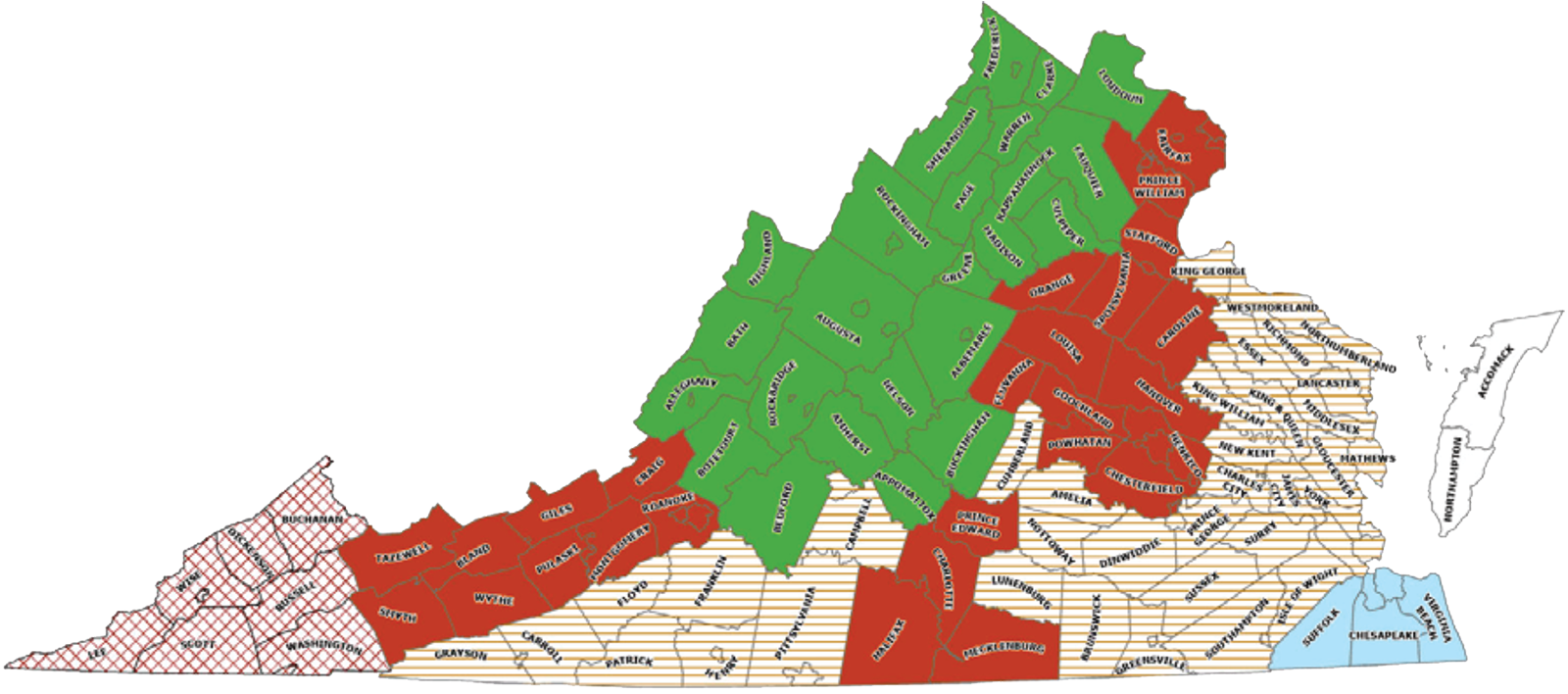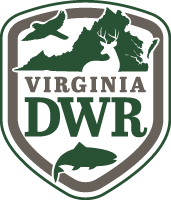General Information
To report a bear, a hunter must have a customer account through GoOutdoorsVA. It is free and easy to set up your account at GoOutdoorsVirginia.com. If you have any problems, please call 804-367-1000.
Bag Limits
One per license year, at least 100 pounds live weight or 75 pounds dressed weight (all internal organs removed). Females with cubs may not be harvested. Cubs may be 30-50 lbs by fall. Please observe and be patient before shooting as cubs often lag behind the female.
Unlawful to Feed or Bait Bears
Feeding or baiting prohibited year round and statewide. Do your part to keep bears wild, reduce human-bear conflicts, and slow the spread of mange. Bears with mange will have hair loss, dry and scaly skin, and sometimes look thin or starving.
Unlawful to Shoot Without Intent to Retrieve the Bear
No person shall kill or cripple and knowingly allow any game animal to be wasted without making a reasonable effort to retrieve the animal and retain it in their possession.
Unlawful to Cripple, Harm, or Dislodge and Continue to Hunt
It is unlawful to cripple, harm or dislodge a bear from a tree for the intent of continuing a hunt, chase, or for the purpose of training dogs.
Bear Harvest Reporting and Tooth Submission
Successful bear hunters must report their harvest through the internet at GoOutdoorsVirginia.com, via the Go Outdoors Virginia mobile app, or by telephone and also submit a bear tooth.
Look Up the Age of Your Harvested Bear Online!
The age of your harvested bear will be available online 9 to 10 months after the hunting season ends on the DWR website.
Tracking Dogs
Allowed
Archery Bear Season
Season Dates
See below.
Legal Methods and Restrictions
Special restrictions apply to archery tackle use during this season. See Legal Use of Firearms and Archery Tackle for more details.
- Archery tackle only, excluding slingbows.
- Persons with a disability that prevents them from drawing a bow or crossbow may hunt with an arrowgun during the special archery season provided they have in possession an authorization form provided by the Department that has been completed by their physician.
- Broadhead widths must be at least 7/8-inch wide or expand upon impact to 7/8-inch.
- It is unlawful to use explosive head arrows or arrows to which any drug, chemical, or toxic substance has been added.
- It is unlawful to use dogs, except that dogs may be used to track wounded or dead bears (see Hunting with Dogs) and dogs may be used by youth or apprentice bear hunters on the Saturday of Youth and Apprentice Bear Hunting Weekend.
- It shall be unlawful to use firearms to hunt any game species while hunting with archery equipment during the special archery seasons, except that hunters 15 years of age and under and apprentice hunters may use firearms to hunt for bear while hunting on youth and apprentice hunter bear hunting weekend and except that a muzzleloading gun may be used by a properly licensed muzzleloading gun hunter when and where the early special archery bear season overlaps the early special muzzleloading bear season.
Youth and Apprentice Bear Hunting Weekend
October 11 and 12
- Hunting weapons legal during the firearms season are allowed on this weekend.
- Statewide
- Resident and nonresident youth hunters 15 years of age and under or holders of a valid apprentice hunting license, when in compliance with all applicable laws and licenses, may hunt when accompanied and directly supervised by an adult over the age of 18 who has a valid Virginia hunting license or is exempt from purchasing a hunting license.
- Nonresident youth of any age need to have the appropriate licenses (unless exempt from purchasing a license).
- Bear bag limit, weight limits, and all other take restrictions apply. If a bear is taken on this weekend, the youth or apprentice hunter may not take another bear in any season.
- Blaze color is required in areas with an open deer firearms season during this weekend.
- Dogs may not be used on Sunday statewide.
- Bears may be taken with the aid of dogs on Saturday statewide except: » In the counties of Accomack, Campbell (west of the Norfolk Southern Railroad), Fairfax, Grayson (west of State Route 16), Henry, Loudoun, Northampton, Patrick, Pittsylvania (west of the Norfolk Southern Railroad), Roanoke (south of I-81), Smyth (that part south of I-81 and west of State Route 16), and Washington (south of I-81) and the city of Lynchburg.
- On the Amelia, C. F. Phelps, Featherfin, G. Richard Thompson, Mattaponi, Mattaponi Bluffs, Merrimac Farm, Oakley Forest, Flippo-Gentry, Pettigrew, Robert W. Duncan, Tye River, and Ware Creek Wildlife Management Areas (WMAs), and other areas posted on WMAs.
- Tracking dogs maintained and controlled on a lead may be used to find a wounded or dead bear.
- Adult hunters accompanying youth or apprentice bear hunters:
- do not need a bear license on this weekend.
- shall not use or discharge a firearm.
- shall maintain close visual and verbal contact with, provide adequate direction to, and can immediately assume control of the firearm.
Muzzleloader Bear Season
Season Dates
See below.
Legal Methods and Restrictions
Special restrictions apply to specific firearms use during this season. See Legal Use of Firearms and Archery Tackle and Local Firearms Ordinances for more details.
- Muzzleloading guns that can be used during this season include:
- Muzzleloading rifles (one or more barrels), .40 caliber or larger, firing a single projectile or sabot (with a .35 caliber or larger projectile) where the projectile is loaded from the muzzle;
- Muzzleloading shotguns (one or more barrels) not larger than 10 gauge where the projectiles are loaded from the muzzle;
- Muzzleloading pistols (one or more barrels) .45 caliber or larger, firing a single projectile or sabot (with a .35 caliber or larger projectile) per barrel where the propellant and projectile are loaded from the muzzle;
- Muzzleloading revolvers .44 caliber or larger, firing a single projectile or sabot (with a .35 caliber or larger projectile) per cylinder where the propellant and projectile are loaded from the forward end of the cylinder. Muzzleloading revolvers sold as .44 caliber and designed to shoot a .45 caliber projectile are legal for use in the muzzleloading season.
- Flintlock, percussion, or electronic ignitions are permitted.
- It shall be unlawful to hunt bear with any firearm other than a muzzleloading gun during the special muzzleloading bear season.
- Smokeless powder is allowed in muzzleloading firearms designed for it. Never use smokeless powder of any type in any quantity in a muzzleloading firearm that is not specifically designed for it.
- Scopes are permitted.
- Pnuematic arrowguns are allowed.
- It is unlawful to use dogs, except that dogs may be used to track wounded or dead bear (see Hunting with Dogs).
Bear Hunting Seasons

(red crosshatch) In the counties of Buchanan, Dickenson, Lee, Russell, Scott, Washington, and Wise.
- Early Firearms: September 29 through October 1 (except on Clinch Mountain WMA)
- Archery: October 4 through November 14
- Muzzleloader: November 8 through 14
- Firearms: November 24 through January 3
In the counties of Arlington, Bland, Caroline, Charlotte, Chesterfield, Craig, Fairfax, Fluvanna, Giles, Goochland, Halifax, Hanover, Henrico, Louisa, Mecklenburg, Montgomery, Orange, Powhatan, Prince Edward, Prince William, Pulaski, Roanoke, Smyth, Spotsylvania, Stafford, Tazewell, and Wythe.
- Archery: October 4 through November 14
- Muzzleloader: November 8 through 14
- Firearms: November 24 through January 3
In the counties of Albemarle, Alleghany, Amherst, Appomattox, Augusta, Bath, Bedford, Botetourt, Buckingham, Clarke, Culpeper, Fauquier, Frederick, Greene, Highland, Loudoun, Madison, Nelson, Page, Rappahannock, Rockbridge, Rockingham, Shenandoah, and Warren.
- Archery: October 18 through November 14
- Muzzleloader: November 11 through 14
- Firearms: November 28 through 30, and December 22 through January 3
(orange horizontal lines) In the counties of Amelia, Brunswick, Campbell, Carroll, Charles City, Cumberland, Dinwiddie, Essex, Floyd, Franklin, Gloucester, Grayson, Greensville, Henry, Isle of Wight, James City, King & Queen, King George, King William, Lancaster, Lunenburg, Mathews, Middlesex, New Kent, Northumberland, Nottoway, Patrick, Pittsylvania, Prince George, Richmond, Southampton, Surry, Sussex, Westmoreland, and York.
- Archery: October 4 through November 14
- Muzzleloader: November 8 through 14
- Firearms: December 1 through January 3
In the cities of Chesapeake, Suffolk, and Virginia Beach.
- Archery: October 4 through November 14
- Firearms: October 1 through January 3
In the counties of Accomack and Northampton.
- Closed season
Towns and Cities
Bears may be harvested using any lawful weapon within the incorporated limits of any town or city that allows bear hunting from October 4 through January 3. This season will not supersede local ordinances with respect to hunting or use of weapon.
Legal Methods and Restrictions
Special restrictions apply to specific firearms use during this season. See Legal Use of Firearms and Archery Tackle and Local Firearms Ordinances for more details.
- Modern firearms
- Arrowguns are allowed
- Archery tackle (excludes slingbows)
- Muzzleloading firearms
Dogs May Not Be Use to Hunt Bears:
- It is unlawful to hunt or kill a bear on Sunday (1) with a gun, firearm, or other weapon within 200 yards of a place of worship or any accessory structure thereof, or (2) with a gun, firearm, or other weapon with the aid or assistance of dogs.
- November 24 through 30 in the counties west of the Blue Ridge and in the counties of Amherst (west of Rt. 29), Bedford, and Nelson (west of Rt. 151).
- November 24 through November 28 in Madison and Greene counties.
- During the firearms bear season in the counties of Campbell (west of Norfolk Southern Railroad), Carroll (east of the New River), Fairfax, Floyd, Franklin, Grayson (east of the New River), Henry, Loudoun, Montgomery (south of I-81), Patrick, Pittsylvania (west of Norfolk Southern Railroad), Pulaski (south of I-81), Roanoke (south of I-81), and Wythe (southeast of the New River or that part bounded by Rt. 21 on the west, I-81 on the north, the county line on the east, the New River on the southeast and Cripple Creek on the south), and in the city of Lynchburg.
- On the Amelia, C. F. Phelps, Doe Creek, Featherfin, G. Richard Thompson, Mattaponi, Mattaponi Bluffs, Merrimac Farm, Oakley Forest, Flippo-Gentry, Pettigrew, Robert W. Duncan, Tye River, and Ware Creek Wildlife Management Areas (WMAs), and other areas posted on WMAs.
- When hunting during the archery or muzzleloading bear seasons, except in certain counties during the youth/apprentice bear hunting weekend.
- On Cavalier WMA except during the Bear Hound Training Season from August 9 through 23. Dogs may not be used to hunt bears at any other time.
Bear Hound Training/Chase Seasons

NO BLACK BEAR MAY BE TAKEN DURING THIS SEASON.
Hours
4:00 a.m. to 10:00 p.m., including Sundays (except as noted under the map below). See maps and information below for dates, locations, and other restrictions.
Licenses Required
Same for hunting seasons where bears can be taken. See licenses, stamps, and permits section for appropriate required licenses.
Unlawful Methods
- It is unlawful to dislodge an animal from a tree for the intent of continuing a hunt, or chase, or for the purpose of training dogs.
- It is unlawful to chase, hunt, or train dogs from baited sites or with use of bait.
- It shall be unlawful to use for the purpose of taking a bear any firearm, bow, crossbow, or any weapon capable of taking a black bear while participating in the bear hound training season.
In the counties of Albemarle, Alleghany, Amherst, Augusta, Bath, Bedford, Botetourt, Culpeper, Greene, Highland, Madison, Nelson, Page, Rappahannock, Rockbridge, Rockingham, Shenandoah, and Warren
- August 1 through September 27 (including Sundays), December 1 through December 20 (excluding Sundays)
In the counties of Brunswick, Greensville, and Lunenburg.
- August 1 through September 27 (including Sundays), November 15 through November 29 (including Sundays)
In the counties of Charlotte and Mecklenburg
- August 1 through September 27 and November 15 through November 23 (all including Sundays)
In the counties of Halifax and Prince Edward
- November 15 through November 23 (including Sundays)
In the counties of Bland, Buchanan, Carroll, Craig, Dickenson, Franklin, Floyd, Giles, Grayson (East of State Rt 16), Lee, Montgomery, Pulaski, Roanoke (North of 81), Russell, Scott, Smyth (East of State Rt. 16 and north of I-81), Tazewell, Washington (North of 81), Wise, and Wythe and the Cities of Chesapeake, Suffolk, and Virginia Beach
- August 1 through September 27 (including Sundays) except Cavalier WMA (August 9 through August 23)
In the counties of Amelia, Campbell (East of Norfolk Southern Railroad), Charles City, Cumberland, Dinwiddie, Essex, Gloucester, Isle of Wight, James City, King & Queen, King George, King William, Lancaster, Mathews, Middlesex, New Kent, Northumberland, Nottoway, Pittsylvania (East of Norfolk Southern Railroad), Prince George, Richmond, Southampton, Surry, Sussex, Westmoreland, and York
- November 15 through November 29 (including Sundays)
In the counties of Appomattox and Buckingham
- November 15 through November 27 (including Sundays), December 1 through December 20 (excluding Sundays)
(orange horizontal lines) In the counties of Clarke, Fauquier, and Frederick
- December 1 through December 20 (excluding Sundays)
In the counties of Accomack, Campbell (West of Norfolk Southern Railroad), Caroline, Chesterfield, Fairfax, Fluvanna, Goochland, Grayson (West of State Rt 16), Hanover, Henrico, Henry, Loudon, Louisa, Northampton, Orange, Patrick, Pittsylvania (West of the Norfolk Southern Railroad), Powhatan, Prince William, Roanoke (South of 81), Smyth (West of State Rt. 16 and south of I-81), Spotsylvania, Stafford, Washington (South of 81)
- Closed Season
Information for Hunters Regarding Black Bears with Mange
Sarcoptic mange is a highly contagious skin disease of mammals caused by mites. It is the most common agent isolated in severely affected black bears. S. scabiiei has a wide host range that includes dogs, foxes, coyotes, horses, cows, cats, and numerous other domestic and wildlife species. Humans are susceptible to S. scabiiei infestation but most infections are mild and do not require treatment.
Hunters should carefully evaluate bears before harvest and refrain from harvesting bears that show any signs of mange. Determining if a bear has mange can be difficult in the field, especially because other conditions can appear similar to mange, such as normal shedding. The DWR mange brochure contains photos of bears with mange along with additional characteristics to look for to help in your assessment. Research and experience in other states show that many bears with mild to moderate cases can survive and clear symptoms of mange. If you have any doubts, please refrain from harvesting the bear; instead, take photos, note your exact location (take GPS coordinates, if possible) and submit this information to the Virginia Wildlife Conflict Helpline at vawildlifeconflict@usda.gov or (1-855-571-9003). Reports not only help us track the prevalence and spread of mange but also help guide our research and decisions about hunting seasons in affected areas.
Bear Training Seasons
- A mange-infested bear cannot be killed during any bear training (chase) seasons. Hunters should report any mange-suspect bear observed while training to the Virginia Wildlife Conflict Helpline as soon as possible (with photos and location coordinates): vawildlifeconflict@usda.gov or (1-855-571-9003).
Harvesting a Mange-Infested Bear
- If a hunter harvests a bear with signs of mange during an open bear season (regardless of condition/degree of infestation), they must utilize their bear tag and report the bear at the time of harvest. Reporting the harvest of a bear (including those with mange) is both required by law and is a vital element of the Department’s bear management program.
- Because humans can contract mange, handling of the bear carcass isn’t required, and the bear does not need to be removed from the place of harvest.
- A photo of the bear (at the time of harvest) along with GPS coordinates or specific location should be collected. Photos should include potential evidence of mange (lack of hair, crusting skin, etc.) so that staff can evaluate the animal effectively and efficiently.
- IMPORTANT: The harvested bear should be reported to bearmange@dwr.virginia.gov with the photo and confirmation number from reporting the harvest. DWR will evaluate the submission and contact the hunter regarding license status or to collect additional information on the harvested bear’s condition. If DWR can confirm that the bear had mange, the hunter will be eligible for a replacement bear tag, if they so desire. If you do not have access to email, you may call the Virginia Wildlife Conflict Helpline as soon as possible (1-855-571-9003), however there may be some delays when reporting by phone.
Best Management Practices for Possible Exposure to a Mange-Infested Bear
- Handling of a mange-infested bear should be minimized to avoid unnecessary exposure. Hunters should take precautions if handling and/or disposing of the pelt and carcass. These precautions include wearing disposable gloves, using a Permethrin-based insect repellent on clothes/gear (as instructed by the label), bagging gloves and any other disposable equipment after use, and disposing of them in a dumpster or similar location. Hands and arms should be washed thoroughly with soap. Contaminated clothing should be washed and machine-dried with heat or placed in a freezer overnight to kill any mites. If the carcass of a bear with signs of mange is removed from the harvest site, the hunter should try to dispose of the pelt by double-bagging or returning it to the site of harvest.
- Hunters should contact their veterinarian to discuss options for their hounds that may have come into contact with a mange-infested bear or an area occupied by a mange-infested bear (e.g., den, bedding site, etc.).
- Equipment (dog leashes, dog box, etc.) should be disinfected (e.g., 40% bleach solution or other disinfectant cleaner for equipment and clothing) if suspected of being in contact with a mange-infested bear or with a dog that has come into contact with a mange-infested bear.
- Contact your health care provider for more information related to a potential exposure to mange.

